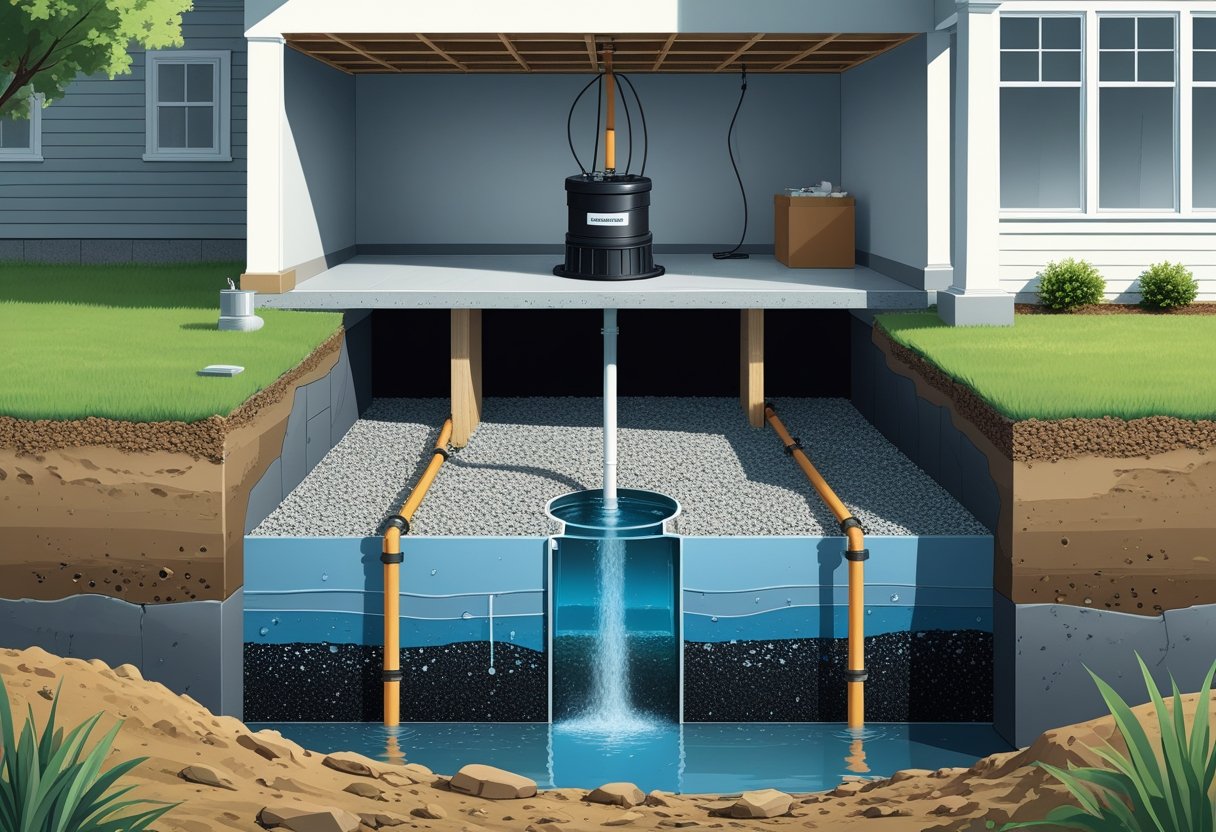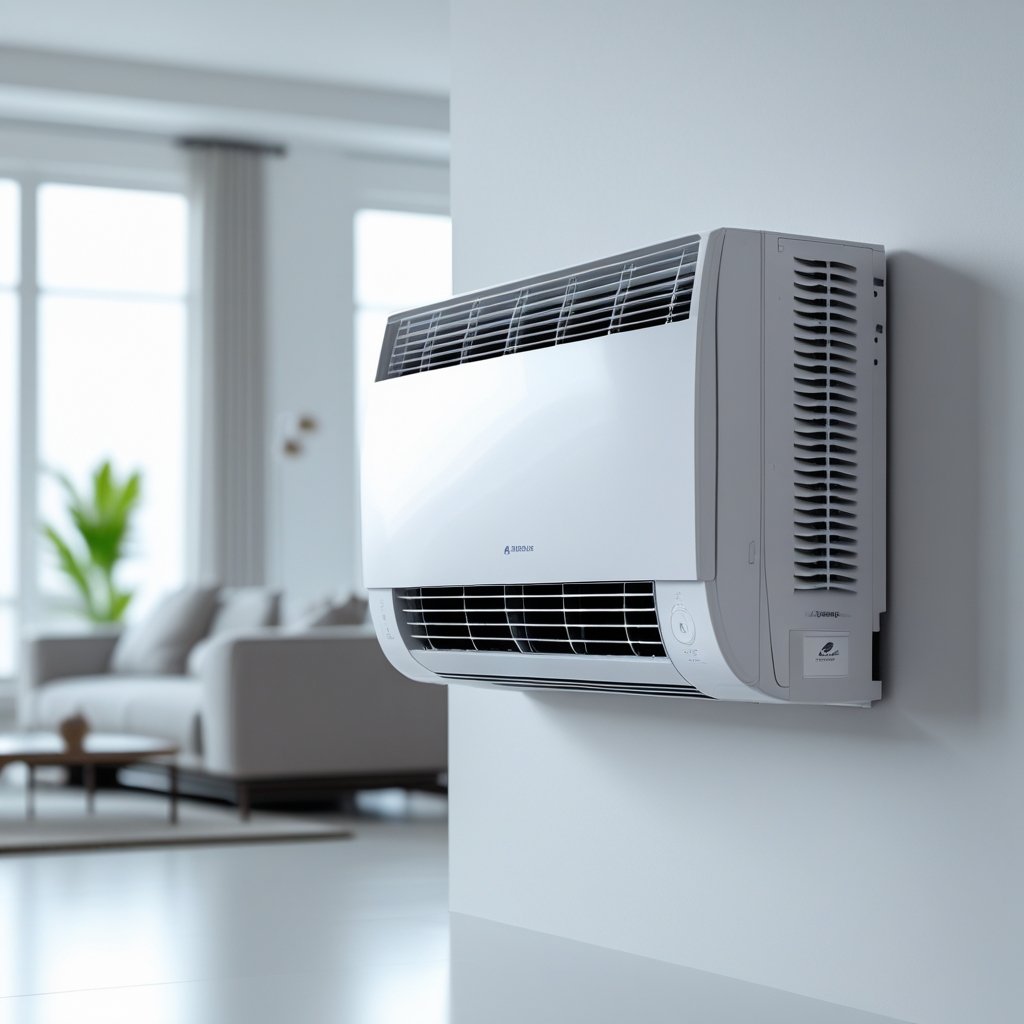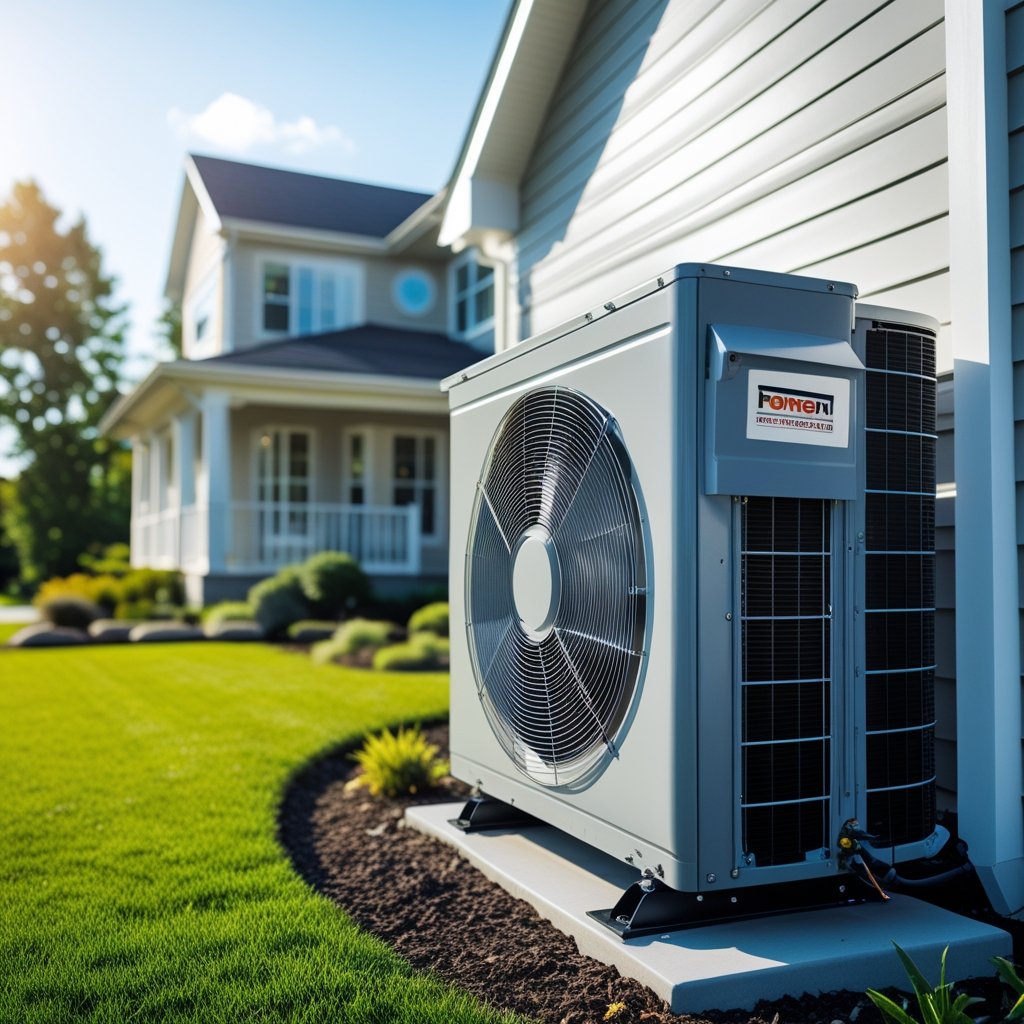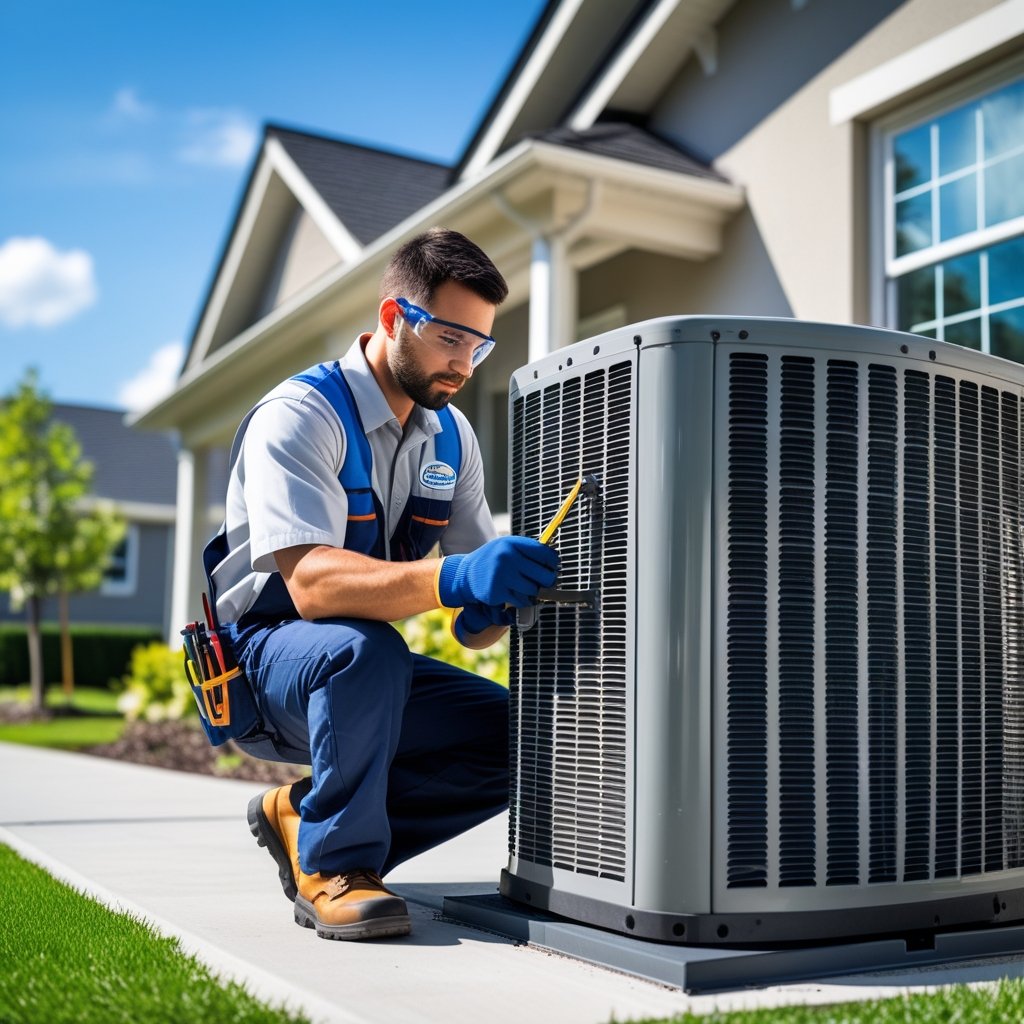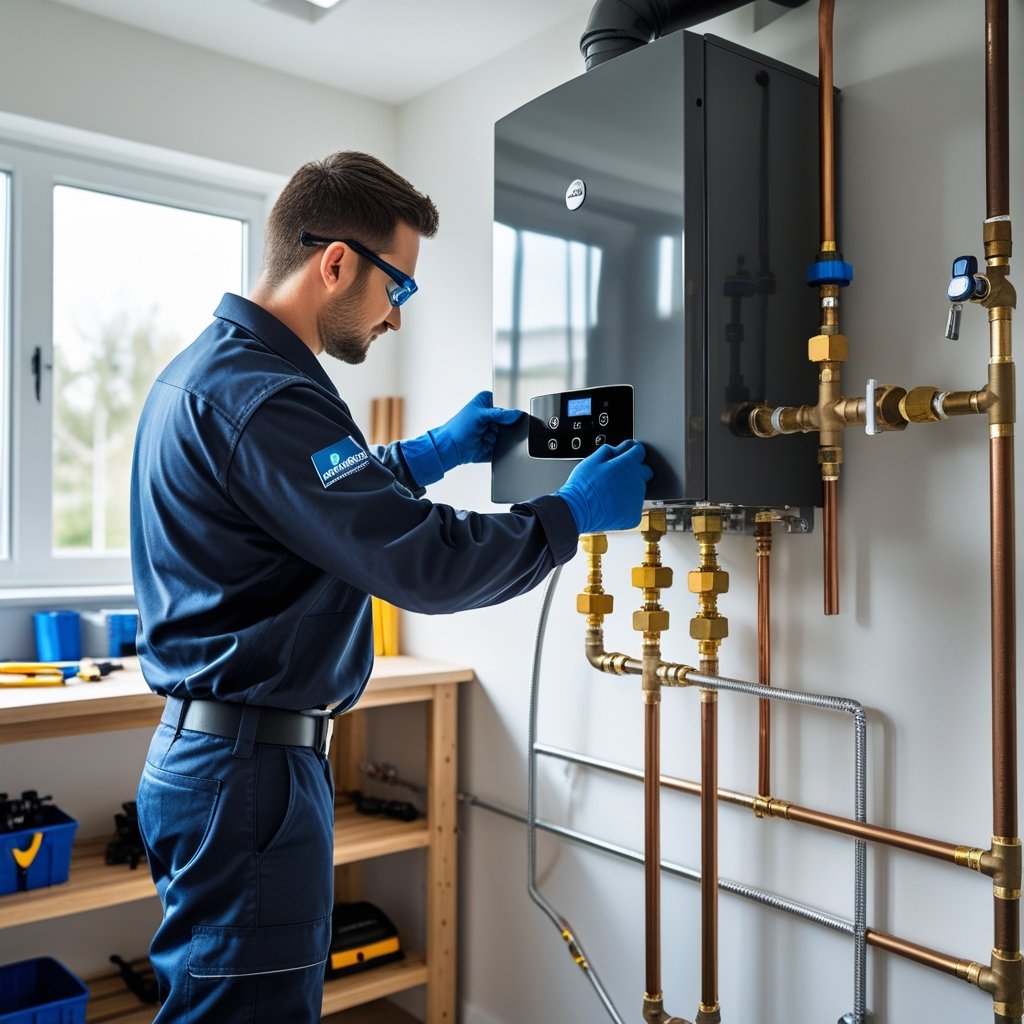Basement floods can wreck your stuff and lead to expensive repairs. The best way to avoid basement floods is to keep water away from your home by maintaining gutters, grading your yard properly, and checking your plumbing regularly. Just a few easy habits can save you a huge headache down the line.
Small leaks or drainage problems sometimes sneak up on you. That’s why it’s smart to stay vigilant. At Leo Kob Co., we help folks in South Central Pennsylvania catch issues early with thorough plumbing and drainage checks.
So, what’s at stake? With a little effort, you can dodge water damage all year. Let’s dig into how to spot risks and what actually works to keep your basement dry.
Identifying Basement Flood Risks
If you know what puts your basement in danger, you’re way ahead. Keep an eye out for drainage issues, leaks, and other warning signs. Catching these early can make a world of difference.
Common Causes of Basement Water Intrusion
Water sneaks into basements from all sorts of places. Poor drainage is a major culprit—if rainwater pools around your foundation, it’ll find a way in.
Cracked foundation walls are another biggie. And don’t overlook clogged or busted gutters and downspouts; they can dump water right against your house.
High groundwater, especially after a big storm, sometimes pushes water right through your basement walls or floor. Plumbing leaks inside the house? Also a classic. Tackling these issues early keeps your basement safe.
Warning Signs of Potential Flooding
Watch for the little hints your basement gives you. Musty smells usually mean water’s lurking somewhere. Water stains or odd discoloration on walls and floors? That’s a red flag for leaks or slow seepage.
Bulging or cracked walls can point to outside water pressure. If your sump pump runs nonstop or won’t kick on, it could be on its last legs.
Hear water dripping when nothing’s running? That’s suspicious. And if your yard turns into a pond after rain, your basement might be next. Spot these signs early and you’ll have more options.
Assessing Your Home’s Vulnerabilities
Some homes are just more prone to flooding. Check your yard’s slope—does water run away from your house, or toward it? Try spraying a hose and see what happens.
Peek at your gutters and downspouts. If they’re blocked or leaking, fix them. Downspouts should shoot water at least 4 to 6 feet from the house.
Cracks in basement walls or floor joints need sealing. If you’ve got window wells, make sure they drain and have covers. And don’t forget your sump pump—right size, working properly?
If you’re not sure what you’re looking at, Leo Kob Co. has the experience to spot trouble for homeowners in South Central Pennsylvania.
Exterior Solutions to Prevent Basement Floods
Keeping water outside is where you start. Rain should move away from your foundation, not toward it. That means managing your yard’s slope, cleaning gutters, and maybe adding drainage systems.
Landscaping and Grading for Proper Drainage
Your yard needs to slope away from your house—a 6-inch drop over 10 feet is a good target. Sandy soil helps water drain, while clay just traps it.
Plant grass or other thirsty plants to soak up rain, but keep them trimmed and away from the foundation. You don’t want roots messing with your walls.
Maintaining Gutters and Downspouts
Gutters catch rain off your roof and send it down the spouts. Clean gutters twice a year to keep leaves and gunk out.
Check for leaks or sagging that could dump water near your house. Downspouts should stretch at least 5 feet from the foundation.
Gutter guards cut down on cleaning, but double-check water’s actually flowing away—not splashing back at your walls.
Installing Exterior Drainage Systems
If your home sits low, you might need extra help. French drains—underground pipes—pull water away from your basement.
Surface drains work where water puddles, connecting to pipes that carry it offsite.
Leo Kob Co. has been helping folks in South Central Pennsylvania since 1904. They’ll help you pick the right drainage fix for your property.
Interior Waterproofing Strategies
Inside, your goal is to keep water out and manage any that sneaks in. That means sealing up walls and floors, using sump pumps, and adding coatings that block moisture.
Sealing Basement Walls and Floors
Seal cracks or gaps in your basement’s walls and floors with hydraulic cement or waterproof sealants made for concrete. Focus on spots where walls meet floors—moisture loves to sneak in there.
Clean the area before sealing so it sticks. For older homes, it might be worth getting a professional to take a look. Leo Kob Co. knows what to check for in South Central Pennsylvania homes.
Using Sump Pumps Effectively
A sump pump gets rid of water under your basement floor. It kicks on automatically when water fills the sump basin, pumping it outside.
Pick a pump that fits your basement’s size and how much water you deal with. Battery backups are a lifesaver during power outages.
Keep your pump clean and test it before rainy seasons. Make sure the discharge pipe sends water far from the house. Regular checks beat an emergency any day.
Applying Waterproof Coatings
Waterproof coatings build a barrier on basement walls and floors. They’re thicker than normal paint and keep water and vapor out.
Apply them to clean, dry surfaces. Follow the instructions—don’t rush between coats.
Look for coatings that handle both water and vapor to keep mold and mildew away. Adding this step to your basement care routine helps your basement last longer.
Reliable waterproofing isn’t a DIY job for everyone. Leo Kob Co. can handle it with quality service if you want it done right.
Plumbing and Drainage Maintenance
Keeping your basement dry takes regular plumbing and drainage checks. Early attention keeps water flowing where it should and catches problems before they get big.
Inspecting and Cleaning Floor Drains
Floor drains help carry away extra water. Check them now and then to make sure they aren’t clogged with dirt or grease. Scoop out any gunk and flush with hot water.
If water drains slow, try a drain snake or call a pro. Skip harsh chemicals—they’re rough on pipes and the planet. Clean drains keep water moving and your basement dry.
Checking for Pipe Leaks and Cracks
Leaks or cracks in pipes can let water sneak into your basement. Take a look at exposed pipes for moisture, rust, or damage. Listen for drips, even when nothing’s running.
Seal small leaks with plumber’s tape as a quick fix, but call someone like Leo Kob Co. for real repairs. Staying on top of pipe maintenance now saves you big headaches later.
Foundation and Structural Upgrades
Fixing foundation issues and managing water flow inside your basement are big steps to stop flooding. Two solid options: repairing cracks in your foundation and adding interior drain tile systems.
Repairing Foundation Cracks
Cracks let water in—simple as that. Check your foundation for small breaks or gaps. Even tiny ones can let moisture creep through.
Fill cracks with hydraulic cement for leaks or epoxy for structural issues. Hydraulic cement expands as it dries, which is handy for active leaks. Epoxy’s better for stable, dry cracks.
If you spot a serious crack, don’t guess—get a pro’s opinion. Leo Kob Co. offers honest assessments and repairs for South Central Pennsylvania homes.
Installing Interior Drain Tile Systems
If water pools around your foundation, interior drain tile systems can help. These are perforated pipes installed along your basement’s inside footing, under the floor.
Water seeps into the pipes through gravel, then flows to a sump pump or drain. This stops water from building up and pushing through your walls.
Installing these drains means breaking up part of your basement floor, laying pipes, and connecting them to a sump pit. It’s not a weekend project, but it pays off.
Leo Kob Co. installs these systems for homes in Lancaster, Harrisburg, and nearby areas.
Seasonal and Weather-Related Flood Prevention
Weather and seasons play a big role in basement flooding. Staying ahead of heavy rains or snowmelt can keep your home safe.
Protecting Against Heavy Rainfall
Heavy rain can swamp your drainage fast. Make sure gutters and downspouts are clear so water flows away from your foundation. Downspouts should stretch at least 4-6 feet out.
Check your yard’s grading—soil should slope away from your house by 6 inches over 10 feet. That keeps rainwater moving downhill.
In storm-prone South Central Pennsylvania, a sump pump or backup battery system is a smart move. These devices keep water out even when the power’s out.
Leo Kob Co. can check and maintain your systems before the next big storm.
Preparing for Thaw and Snowmelt
When snow melts, water can overwhelm your basement fast. Shovel snow away from the foundation to keep it from seeping in.
Test your sump pump before the thaw hits, and make sure the discharge line isn’t blocked or frozen.
If you have a drainage system, look for winter damage—cracks or gaps—and fix them before leaks start.
Applying waterproof sealant to basement walls before winter can help keep moisture out when everything thaws.
Emergency Response for Flood Prevention
When a big storm or sudden backup threatens your basement, acting fast matters. Temporary barriers and working sump pumps are your best friends in a pinch.
Temporary Flood Barriers
Temporary barriers, like sandbags or water-filled tubes, can block water from getting in through doors and windows.
Set them up tightly and use towels or plastic sheets underneath to seal small gaps. Keep supplies handy—you don’t want to be hunting for them during a storm.
Inflatable barriers are another option; they’re easy to store and fill when needed, but you’ll need a few minutes to get them ready.
Know your basement’s weak spots and set up barriers before water starts rising. Leo Kob Co. suggests checking your supplies once in a while so you’re not caught off guard.
Power Backup Solutions for Sump Pumps
Your sump pump only works with power. Install a battery backup so it keeps running during outages.
Battery backups kick on automatically if the power fails, buying you precious time. For longer outages, a generator sized for your pump is worth considering.
Test your backup twice a year. Make sure batteries or fuel are fresh and switches work.
A reliable sump pump with backup power is a must, especially in South Central Pennsylvania, where weather and outages can hit hard. Leo Kob Co. can help keep your system in shape.
Long-Term Maintenance and Monitoring
Keeping your basement dry isn’t a one-time job. You’ll need to check your waterproofing and update your prevention tools as time goes on. Staying on top of these tasks helps you catch problems early and avoid major damage.
Regular Waterproofing Inspections
Every 6 to 12 months, take a good look at your basement walls, floors, and sump pump. Watch for cracks, peeling paint, or any damp spots—those are the usual suspects when water sneaks in. Give your sump pump a quick test: pour some water into the pit and see if it kicks on and pumps water out quickly. It’s a simple check, but it matters.
Don’t forget about your gutters and downspouts—clean them out at least twice a year. If water flows away from your house like it’s supposed to, you’ve already dodged a lot of flood risk. If you ever notice mold or catch a whiff of musty air, it might be time to call in someone who knows basements inside and out.
Leo Kob Co. does waterproofing inspections that can spot problems before they turn into headaches.
Updating Prevention Systems as Needed
Basements don’t stay the same forever, and your prevention systems shouldn’t either. If your sump pump parts look worn, swap them out. If you lose power a lot, maybe a battery backup pump is worth a thought. Reseal those wall cracks every few years—fresh waterproof sealant can really help keep moisture out.
Take a look at the ground around your house too. The soil should slope away—at least 6 inches over 10 feet. If you see water pooling outside after a storm, it might be time to regrade or put in a French drain. These tweaks keep water pressure off your basement walls and, honestly, can save you a lot of trouble.
If you’re not sure what needs updating, or you just want a second opinion, Leo Kob Co. is always up for a chat about flood prevention.
When to Call a Professional
If your basement floods often or you see water coming in during big storms, don’t wait—call a pro. Persistent water problems can lead to serious damage and mold, and that’s not something you want to mess with on your own.
Reach out if you notice strong odors, damp walls, or paint that’s starting to peel. Those signs usually mean moisture is hiding somewhere behind the scenes. A good technician will track down the cause and actually fix it.
Here’s when someone from Leo Kob Co. can really make a difference:
- Sump pump won’t run or keeps cycling on and off
- Drain tiles around your foundation are broken or clogged
- Cracks in walls or floors that let water in
- Gutters or downspouts aren’t doing their job
- Sewer backup or slow drains
Trying to DIY these problems without the right tools usually just makes things worse. Pros have the gear and know-how to handle the messy stuff safely.
Leo Kob Co. has been around South Central Pennsylvania since 1904, serving places like Lancaster, Harrisburg, and York with real, honest work and no hidden fees. They know their way around basement waterproofing and plumbing.
Waiting usually just means bigger bills down the road. If you want to keep your basement dry and your wallet intact, call someone you trust for a solid inspection and a fix that lasts.
Frequently Asked Questions
Getting your basement ready for heavy rain or high water can save you a lot of stress. The right tools and waterproofing methods really do make a difference.
What steps can I take to prevent my basement from flooding during heavy rain?
Make sure your gutters and downspouts push water at least 5 feet away from your house. Check that the ground slopes away from your foundation. Keep drains clear, and think about a sump pump if you want extra peace of mind.
How can I protect my basement from flooding due to rising groundwater levels?
A perimeter drainage system or French drains can help move groundwater away. Sealing up cracks in your foundation walls and floors goes a long way to keep water out.
What are effective basement waterproofing techniques to avoid water damage?
Waterproof coatings, sealants, and epoxy treatments are common go-tos. Interior drainage and sump pumps help get rid of water that sneaks in. If you want to go all-out, exterior excavation and waterproof membranes protect your foundation from outside moisture.
How can I use sandbags to safeguard my basement against floodwaters?
Put sandbags snugly along doors and low windows. Stack them in a pyramid shape for better stability, and use plastic sheeting under and over the bags for more protection. Just remember, sandbags are really a short-term fix.
In the event of a basement flood, what are my insurance coverage options?
Most standard homeowners insurance covers sudden water damage, but not flooding. You’ll probably need separate flood insurance to cover basement flooding from rain or groundwater. Double-check your policy details—it’s worth it.
What should be my immediate actions if my basement floods following a rainfall?
First things first—shut off the electricity and gas. You don’t want any surprises. Then, grab a pump or wet vacuum and start getting that water out. It’s not glamorous, but the sooner you start drying the place with fans and dehumidifiers, the less chance mold has to take over. If things look really bad or you’re not sure what to do next, it’s probably wise to call in a professional.
For trusted help with plumbing or waterproofing in South Central Pennsylvania, Leo Kob Co. has been around since 1904, serving places like Lancaster and Harrisburg. They’re local, reliable, and fair—worth a call if you’re feeling overwhelmed.

